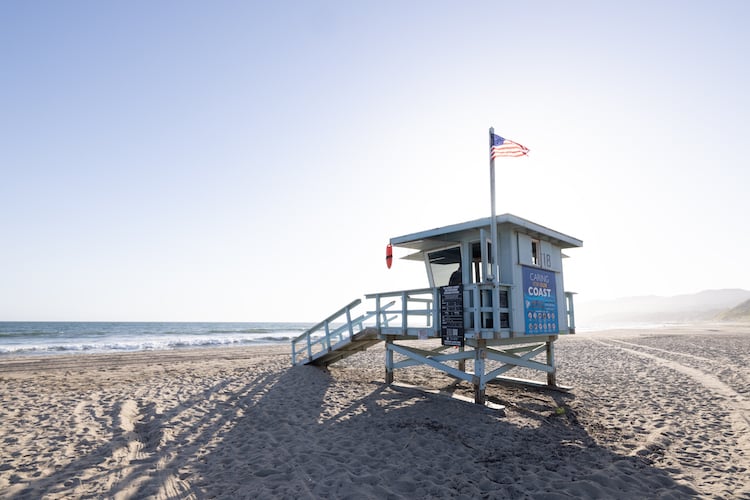
Two lifeguard towers, including No. 18, on “Ginger Rogers Beach,” Los Angeles’ unofficial gay beach and a long-time sandy sanctuary for the LGBTQ+ community, will be painted the colors of the Progress Pride Flag next month after the Los Angeles County Board of Supervisors approved the idea. The site will also be recognized for its historical significance to the LGBTQ+ community. Photo: Los Angeles County Board of Supervisors
UPDATE: Two Pride-painted lifeguard towers unveiled at Ginger Rogers Beach.
Two lifeguard towers on “Ginger Rogers Beach,” Los Angeles’ unofficial gay beach and a long-time sandy sanctuary for the LGBTQ+ community, will be painted the colors of the Progress Pride Flag next month after the Los Angeles County Board of Supervisors approved the idea.
The site also will include signs spotlighting the history and cultural significance of “Ginger Rogers Beach” to the LGBTQ+ community.
Towers 17 and 18 are located on Will Rogers State Beach, just north of the Annenberg Community Beach House in Santa Monica. The stretch of beach located between the towers is “Ginger Rogers Beach,” a section just south of the intersection of Pacific Coast Highway and Entrada Drive.
The unveiling of the lifeguard towers will take place June 17 at 10 a.m. as part of LGBTQ Pride Month.
“Pride month is about celebrating and uplifting the LGBTQ+ community, honoring those who came before us, empowering all in the struggle today, and educating the generations that will lead after us,” said Supervisor Lindsey P. Horvath, who introduced the motion that was passed unanimously on May 2.
“Amidst a despicable rise in anti-LGBTQ+ rhetoric and policy-making throughout the country, we have an important opportunity to honor the history of ‘Ginger Rogers’ Beach, which has long been a safe space for LGBTQ+ people.
“As an advocate and ally, I look forward to celebrating the legacy of ‘Ginger Rogers’ Beach, and the generations of LGBTQ+ Angelenos who have lived out and proud — this June and all year long,” she said.
For too long, the beach has lived in the shadows without its full story and name known in Los Angeles outside of the LGBTQ+ community, Horvath said.
For more than 70 years, “Ginger Rogers Beach” has been a refuge for the LGBTQ+ community, many of them often seeking a retreat from oppression and discrimination found outside this safe haven.
The beach spot became a popular destination for gay men in the 1940s and was soon dubbed “Ginger Rogers Beach” in honor of the glamorous silver screen actress.
Rogers was known for her campy performances and diva persona. Drag queens began emulating her in the 1930 and 1940s.
Throughout the years, “Ginger Rogers Beach” became a landing space for culture, celebration, and political activism, from signature gathering in opposition to McCarthyism and the Vietnam War to fundraisers for AIDS victims.
